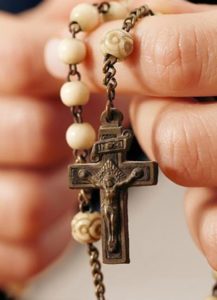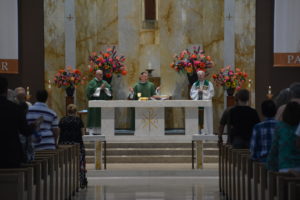Ordination Class of 2017: Encounter, Encouragement, Active Parish Life, Are Key Factors in Discernment Process, Answering the Call
WASHINGTON—According to the Center for Applied Research
in the Apostolate’s (CARA) annual survey, 82 percent of the 2017 class of men
ordained to the priesthood were encouraged by about four people in their lives
including parish priests, friends or other parishioners. The report also says
that ordinands were, on average, 16 years old when they first considered a
vocation to the priesthood, and religious ordinands reported they knew the
members of their religious institute an average of six years before
entering.
Cardinal Joseph W. Tobin, CSsR, of Newark, chairman of
the U.S. bishops’ Committee on Clergy, Consecrated Life and Vocations, notes
that the CCLV Committee has commissioned this annual study since 1998. It
remains part of the ongoing work of the CCLV to highlight various ways that vocations to
the priesthood have been and can be encouraged. The CCLV website features resources
that are available for vocations promotion throughout the United States.
“A staggering number of the 2017 ordination class
report to have been encouraged by others to consider a priestly vocation,”
Cardinal Tobin said. “That statistic should motivate all the faithful to be
sensitive to the work of the Holy Spirit, who may wish to use them to extend
the invitation to ordained ministry.”
The total number of potential ordinands for the class
of 2017, 590, is slightly up from 548 in 2016 and down from 595 in 2015.
The Georgetown University-based Center for Applied
Research in the Apostolate gathered the data for “The Class of 2017: Survey of
Ordinands to the Priesthood.” CARA collects the data annually for the U.S.
bishops’ Secretariat for Clergy, Consecrated Life and Vocations. Approximately 75
percent of the 590 potential ordinands reported to CARA. These 444 respondents
include 343 ordinands to the diocesan priesthood, from 140 different dioceses
and archdioceses, and 101 ordinands to the religious priesthood.
The full report can be found online: www.usccb.org/beliefs-and-teachings/vocations/ordination-class/index.cfm.
Among the survey’s major findings:
On average, they lived in the diocese or eparchy for
which they will be ordained for 16 years before entering seminary.
″ The average age for the Class of 2017 is 34. Since
1999, the average age of responding ordinands has decreased by approximately
two months each year, from an average of 36 in 1999 to the current average age
of 34.
″ Seven in ten ordinands are Caucasian and three in
four were born in the United States. One in four respondents were born outside
the United States, with the largest numbers coming from Colombia, Mexico, the
Philippines, Poland and Vietnam. On average, respondents born in another
country have lived in the United States for 12 years.
″ Most ordinands have been Catholic since infancy, and
eighty percent report that both of their parents are Catholic and more than a
third (35 percent) have a relative who is a priest or a religious. The average
age of conversion was 21, among those who became Catholic later in life.
″ Nearly half completed college (43 percent) before
entering the seminary. One in six (18 percent) entered the seminary with a
graduate degree. The most common fields of study for ordinands before entering
the seminary are theology or philosophy, liberal arts, and business.
″ Nearly half of responding ordinands (between 40 and
50 percent) attended a Catholic school for at least some part of their
schooling, and 59 percent participated in a religious education program in
their parish for an average of seven years.
″ About six in ten ordinands (57 percent) report some
type of full-time work experience prior to entering the seminary, most often in
education. One in twenty ordinands report prior service in the U.S. Armed
Forces. About one in eight ordinands (12 percent) report that either parent had
a military career in the U.S. Armed Forces.
″ Four in five (75 percent) indicate they served as altar
servers and about half (52 percent) report service as a lector. Forty seven
percent of responding ordinands reported participating in “Come and See” weekends
at their seminary or religious institute.
″ About seven in 10 report regularly praying the
rosary (73 percent) and participating in Eucharistic adoration (77 percent)
before entering the seminary.
″ About half (51 percent) indicated that they were
discouraged from considering the priesthood by at least one individual, most
commonly a friend, classmate or family member other than parents.
—
Keywords: ordination, class of 2016, Bishop Michael F.
Burbidge, priesthood, U.S. Conference of Catholic Bishops (USCCB), Center for
Applied Research in the Apostolate (CARA), Secretariat for Clergy, Consecrated
Life and Vocations, diocesan priesthood, religious life, USCCB
# # #
MEDIA CONTACT
Norma Montenegro Flynn
O: 202-541-3202
Categories
From the Desk of Fr. JohnSs. Peter & Paul NewsU.S. Conf. of Catholic BishopsVatican Information ServiceWhat's HappeningUpcoming Events



